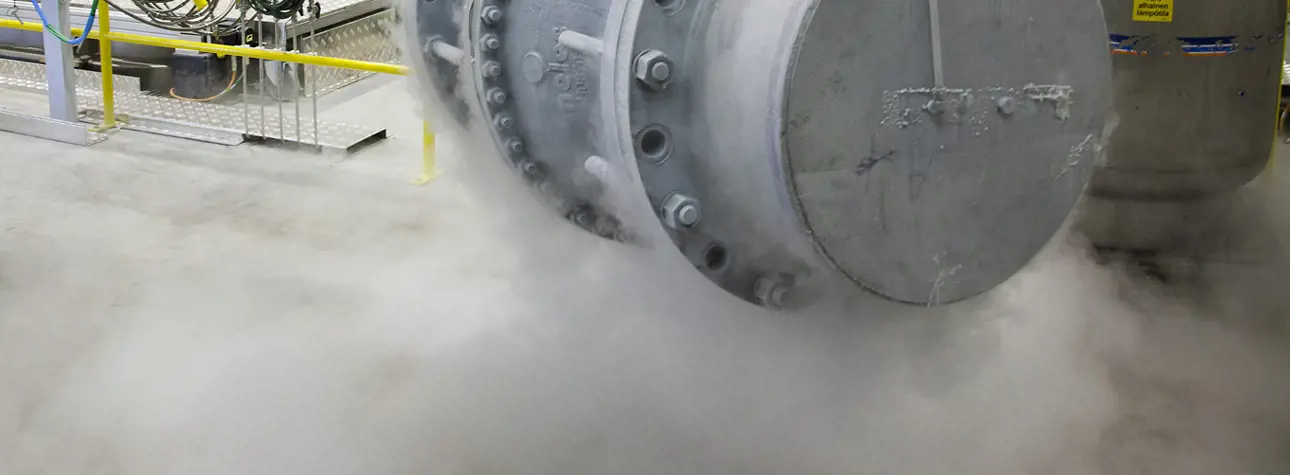Intelligent valves for LNG processing
The demand for natural gas is likely to increase, because of its clean-burning characteristics, especially for producing electricity.

LNG is simply natural gas in its liquid form. Natural gas is converted into LNG by cooling it to -160°C (-260° F), at which point it becomes a liquid. This process reduces its volume by a factor of more than 600, which allows natural gas to be transported efficiently by sea or truck. Once it reaches its destination, LNG is unloaded from ships at import terminals or from trucks at terminals where it is stored as a liquid until it is warmed back to natural gas and sent through pipelines for distribution.
Sari Aronen explains the benefits of selecting the right valves for LNG processing applications.
The LNG production chain comprises of several stages starting from compression, purification, drying and fractionation to liquefaction before the LNG is ready to be shipped by special LNG tankers and sent to end-users.
LNG train processing - before cooling
The numerous impurities that are naturally found in the raw gas freeze at low temperatures, and would thus block the cryogenic section of the plant, the gas has to be purified and dried before it can be cooled down to cryogenic temperatures to avoid freezing in the cold section of the plant. The typical method of drying used is a molecular sieve.
Metal-seated valves, like Neles™ trunnion mounted ball valves, have been widely used for these kinds of demanding switching applications for their reliable operation and excellent response with high-pressure differentials. Trunnion-mounted designs give lower friction and operating torque. Seat construction ensures durable tightness in both directions, even in extreme conditions. This design has proved its long-lasting tightness over years of frequent switching with molecular sieve dust present and constant temperature changes.
LNG - getting it cool

Several control and isolation valves control the levels in vessels, protecting vessels from overpressure, protecting pumps and regulating flow rates, isolating equipment in shutdowns and start-ups and in case of an emergency. In general, valves have either a carbon steel or stainless type body due to cold temperatures. Standard trim materials are usually accepted. Valves are mainly either low temperature or cryogenic designs with cryogenic extensions. Low noise trims are needed in some applications to reduce noise and cavitation in high-pressure differential applications.
Testing cryogenic performance
In LNG processing safety and reliability always come first and therefore type-tested products with field proven experience are required. The LNG chain has designated requirements for the area of cryogenic service from production and storage to shipping and re-gasification in receiving terminals. Challenging factory acceptance testing (FAT) is required, mainly for ESD and on-off valves.

“Along with building a new valve factory, a new cryogenic laboratory has also been built to comply with new increased safety and capacity requirements. The new laboratory is by far the most up-to-date cryogenic testing facility in the world, dedicated to testing valves intended for LNG and other liquefied gas processes. The new laboratory is able to test the whole range of Neles (now Valmet Flow Control business line) Automation’s cryogenic valve offering. Everything from 1” up to 48” ball valves and even as big as 100” high-performance flanged butterfly valves can be tested to verify their suitability to the most demanding process requirements.”
Success story: Molecular sieving

After years of operation the valves proved to have operated reliably and during inspections it was observed that the need for maintenance was minimal. There were no major repairs done during the operational life of the valves. Following this experience in one train, the customer decided to replace rising-stem type ball valves with Neles™ trunnion-mounted ball valves in the other two trains as well. As a result of this valve upgrade, this LNG-plant was able to reduce valve maintenance costs and to significantly reduce the operational costs that they experienced with the rising stem valves in the molecular sieve switching applications.
Conclusion
Single-source responsibility of all components manufactured, fully tested and configured will ensure the proper performance of valves from compression, purification, drying, fractionation and cryogenic liquefaction to storage and re-gasification throughout the whole life cycle. An intelligent valve controller provides the means for simple and reliable instrumentation with transparency to valves’ performance while the process is running.
Text by Sari Aronen. For additional information on the topic, please contact ville.kahkonen@valmet.com
Article published as 'Intelligent valves' in LNG Industry magazine Winter 2011 issue
Text originally published in 2012, and slightly updated in April 2022, due to the company name change to Valmet.

Subscribe to our newsletter
Subscribe now to flow control newsletter and receive the latest insights directly to your email.
SubscribeRead more